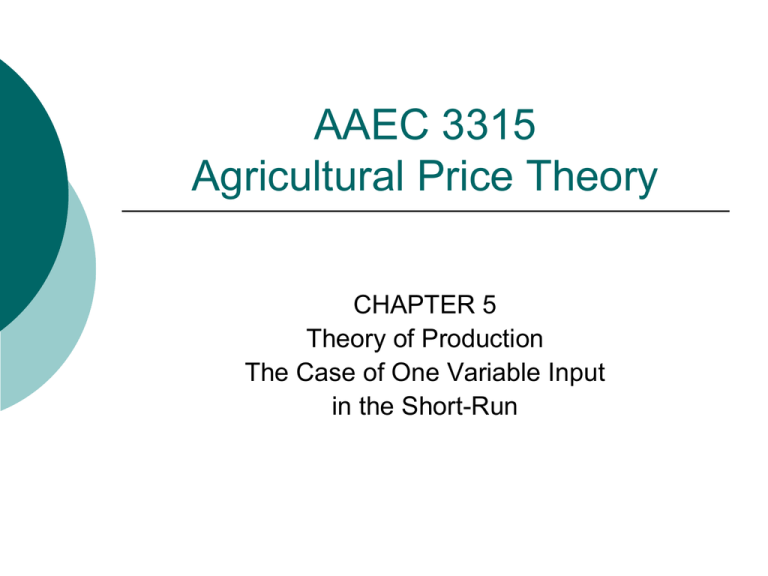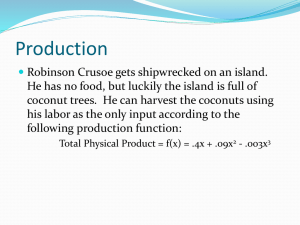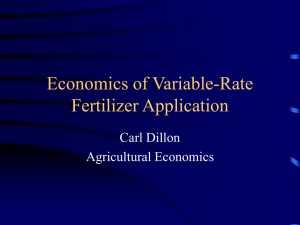Theory of Production - Department of Agricultural and Applied
advertisement

AAEC 3315 Agricultural Price Theory CHAPTER 5 Theory of Production The Case of One Variable Input in the Short-Run Objectives To gain understanding of: Theory of Production Production Curves Total Physical Product Average Physical Product Marginal Physical Product Law of Diminishing Physical Product Stages of Production Production Functions Production Relationships Definition: The technical relationship between inputs & output indicating the maximum amount of output that can be produced using alternative amounts of variable inputs in combination with one or more fixed inputs under a given state of technology. Or, simply speaking, it is the technical relationship between inputs & output Product Curves The Case of One Variable Input X TPP=Y 0.00 0.00 1.00 10.00 2.00 25.00 3.00 50.00 4.00 70.00 5.00 85.00 6.00 95.00 7.00 100.00 8.00 101.00 9.00 95.00 10.00 85.00 Total Physical Product (TPP) illustrates the technological or physical relationship that exists between output and one variable input, ceteris paribus Starts increasing at an increasing rate. Continues to increase but at a decreasing rate Reaches the maximum, then decreases The functional form of a production function is: Y = f (X), where Y is the quantity of output and X is the quantity of input Y TPP X Product Curves Y The point where TPP changes from increasing at an increasing rate to increasing at a decreasing rate is called the Inflection Points. Points A, B, and C Indicate total amount of output produced at each level of input use Maximum Point Y3 C Y2 B TPP Inflection Point Y1 A X1 X2 X3 X Product Curves (Cont.) Average Physical Product (APP) - shows how much production, on average, can be obtained per unit of the variable input with a fixed amount of other inputs X TPP=Y APP 0.00 0.00 1.00 10.00 10.00 2.00 25.00 12.50 3.00 50.00 16.67 4.00 70.00 17.50 5.00 85.00 17.00 6.00 95.00 15.83 7.00 100.00 14.29 8.00 101.00 12.63 9.00 95.00 10.56 10.00 85.00 8.50 Indicates average productivity of the inputs being used how productive is each input level on average APP = Y / X Drawing a line from the origin which is tangent to the TPP curve gives APP max Y TPP Y X APP X Product Curves (Cont.) X TPP=Y MPP 0.00 0.00 1.00 10.00 10.00 2.00 25.00 15.00 3.00 50.00 25.00 4.00 70.00 20.00 5.00 85.00 15.00 6.00 95.00 10.00 7.00 100.00 5.00 8.00 101.00 1.00 9.00 95.00 -6.00 10.00 85.00 -10.00 Marginal Physical Product (MPP) - represents the amount of additional (i.e., marginal) output obtained from using an additional unit of variable input (X). MPP = ΔY / ΔX = ∂Y/∂X or the slope of the TPP curve. Thus, MPP represents the rate of change in output resulting from adding one more unit of input Since MPP is the slope of TPP, it reaches a maximum at inflection point It reaches zero at the maximum point of TPP Y TPP X Y APP MPP X Product Curves Y X TPP=Y APP MPP 0.00 0.00 1.00 10.00 10.00 10.00 2.00 25.00 12.50 15.00 3.00 50.00 16.67 25.00 4.00 70.00 17.50 20.00 5.00 85.00 17.00 15.00 6.00 95.00 15.83 10.00 7.00 100.00 14.29 5.00 8.00 101.00 12.63 1.00 9.00 95.00 10.56 -6.00 10.00 85.00 8.50 -10.00 TPP X Y APP MPP is negative MPP X Relationships between Product Curves MPP reaches a maximum at inflection point MPP = 0 occurs when TPP is maximum MPP is negative beyond TPP max Y TPP Drawing a line from the origin which is tangent to the TPP curve gives APP max At point where APP is max, MPP crosses APP (MPP=APP) When MPP > APP, APP is increasing When MPP = APP, APP is at a max When MPP < APP, APP is decreasing X Y The relationship between TPP, APP, & MPP is very specific. If we have COMPLETE information about one curve, the other two curves can be derived. APP MPP is negative MPP X Law of Diminishing Marginal Physical Product Law of Diminishing Marginal Physical Product: As additional units of one input are combined with a fixed amount of other inputs, a point is always reached where the additional product received from the last unit of added input (MPP) will decline This occurs at the inflection point Stages of Production: Rational & Irrational The stage I of the production function is between 0 and X1 units of X. In stage I: TPP is increasing APP is increasing MPP increases, reaches a maximum & decreases to APP Stage I is an irrational stage because APP is still increasing Y I TPP X Y APP 0 X1 MPP X Stages of Production: Rational & Irrational The stage II of the production function is between X1 and X2 units of X. In Stage II: TPP is increasing APP is decreasing MPP is decreasing and less than APP, but still positive Y I TPP II X Y RATIONAL STAGE BECAUSE TPP IS STILL INCREASING APP 0 X1 X2 MPP X Stages of Production: Rational & Irrational Stage III of the production function is beyond X2 level X In Stage III: TPP is decreasing APP is decreasing MPP is decreasing and negative Y I TPP II III X Y IRRATIONAL STAGE BECAUSE TPP IS DECREASING APP 0 X1 X2 MPP X A Hypothetical Production Function Schedule Total Physical Product Curve Input (X) TPP (Y) APP (Y/X) 0 0 0 1 10 10 10 2 25 12.5 15 3 50 16.67 25 4 70 17.5 20 5 85 17 15 6 95 15.83 10 7 100 14.29 5 8 101 12.63 1 9 95 10.55 -5 10 85 8.5 -10 MPP (ΔTPP/ ΔX) Output Stage I Stage II Stage III Input APP/MPP APP and MPP 0 1 2 3 4 5 Input 6 7 8 9 10 Effects of Technological Change We know that the PF gives the max amount of output that can be produced by a firm using a given technology. The PF can shift over time as a result of a technological change Technological change refers to the introduction of new technology that increases output with the same amount of resources. Y TPP1 TPP X Elasticity of Production The elasticity of production measures the degree of responsiveness between output and input. Q X Q X Q Q MPP Ep Q X X Q X X APP Q X Using Calculus: Ep X Q Like any other elasticity, elasticity of production is independent of units. It measures the percentage change in production in response to a percentage change in variable input. A Hypothetical Production Function A Mathematical Example Consider a Production Function TP = X2 – 1/30X3, where TP (Y) is quantity of output and X is the quantity of input. AP = TP/X = X – (1/30)X2 Y I II TPP III X Y MP = ∂TP/∂X = 2X – (3/30)X2 = 2X – (1/10) X2 APP 0 MPP X A Hypothetical Production Function A Mathematical Example oGiven Y oTP = X2 – (1/30)X3, oAP = TP/X = X – (1/30)X2 oMP = ∂TP/∂X = 2X – (1/10)X2 I II III oAt what levels of X does the MP reach its maximum? oMP reaches its maximum where ∂MP/∂X = 0 TPP X Y oThat is, where o 2 – (2/10)X = 0 oOr, 0.2 X = 2 oOr, X = 10 APP 0 10 MPP X A Hypothetical Production Function A Mathematical Example o Given Y oTP = X2 – (1/30)X3, oAP = TP/X = X – (1/30)X2 oMP = ∂TP/∂X = 2X – (1/10)X2 I II TPP III o At what levels of X does the AP reach its maximum? o AP reaches its maximum where ∂AP/∂X = 0 X Y o That is, where o1 – (2/30)X = 0 oOr, (1/15) X = 1 oOr, X = 15 APP 0 10 15 MPP X A Hypothetical Production Function A Mathematical Example o Given, Y oTP = X2 – (1/30)X3, oAP = TP/X = X – (1/30)X2 oMP = ∂TP/∂X = 2X – (1/10)X2 I TPP II III o At what levels of X does the TP reach its maximum? oTP reaches its maximum where ∂TP/∂X = MP = 0 X Y oThat is, where oMP = 2x – (1/10)X2 = 0 oUsing the quadratic formula of oX = 20 APP 0 10 15 20 MPP X A Hypothetical Production Function A Mathematical Example o Given Y oTP = X2 – (1/30)X3, oAP = TP/X = X – (1/30)X2 oMP = ∂TP/∂X = 2X – (1/10)X2 I TPP II III o What is the range of X values for Stage II? o Stage II is the stage that begins where AP is at its maximum and ends where TP is at its maximum. X Y o Thus, the range of X values or Stage II is 15 and 20. APP 0 10 15 20 MPP X A Hypothetical Production Function A Mathematical Example o Given Y oTP = X2 – (1/30)X3, oAP = TP/X = 2X – (1/30)X2 oMP = ∂TP/∂X = 2X – (1/10)X2 I TPP II III o At what level of X does the Law of Diminishing Returns set in? o It sets in where MP reaches its maximum. X Y o Thus at X = 10 the law of Diminishing returns sets in. APP 0 10 15 20 MPP X A Hypothetical Production Function A Mathematical Example o Given TP = X2 – (1/30)X3, o At Y = 112.5 and X = 15, what is the elasticity of production? o Applying Ep Q X X Q o Ep = (2X – (1/10) X2) * (X/Q) o Ep = ((2*15) – (225/10)) * (15/112.5) o Ep = (30 – 22.5) * (0.133) o Ep = 7.5 * 0.133 = 0.997








